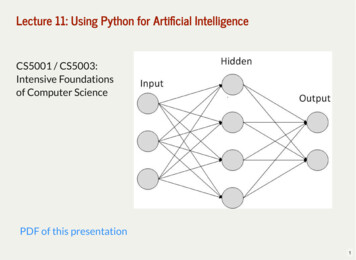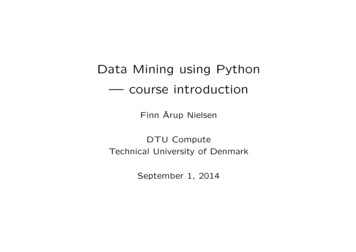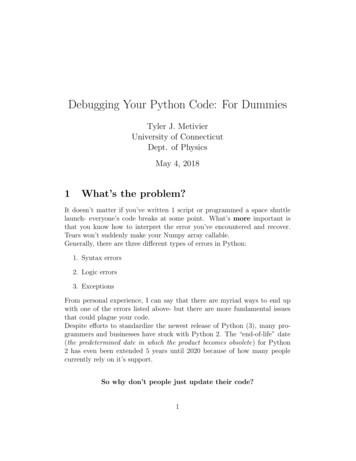
Transcription
Lecture 11: Using Python for Artificial IntelligenceCS5001 / CS5003:Intensive Foundationsof Computer SciencePDF of this presentation1
Lecture 11: Using Python for Artificial IntelligenceToday's topics:Introduction to Artificial IntelligenceIntroduction to Artificial Neural NetworksExamples of some basic neural networksUsing Python for Artificial IntelligenceExample: PyTorch2
Lecture 11: Introduction to Artificial IntelligenceVideo Introduction1950: Alan Turing: Turing Test1951: First AI program1965: Eliza (first chat bot)1974: First autonomous vehicle1997: Deep Blue beats Gary Kasimov at Chess2004: First Autonomous Vehicle challenge2011: IBM Watson beats Jeopardy winners2016: Deep Mind beats Go champion2017: AlphaGo Zero beats Deep Mind3
Lecture 11: Introduction to Artificial Neural Networks (ANNs)NNs learn relationship between cause and effect or organizelarge volumes of data into orderly and informative patterns.Slides modified from PPT by Mohammed Shbier4
Lecture 11: Introduction to Artificial Neural Networks (ANNs)A Neural Network is a biologically inspired informationprocessing idea, modeled after our brain.A neural network is a large number of highlyinterconnected processing elements (neurons) workingtogetherLike people, they learn from experience (by example)5
Lecture 11: Introduction to Artificial Neural Networks (ANNs)Neural networks take their inspiration from neurobiologyThis diagram is the human neuron:6
Lecture 11: Introduction to Artificial Neural Networks (ANNs)A biological neuron hasthree types of maincomponents; dendrites,soma (or cell body) and axonDendrites receives signalsfrom other neuronsThe soma, sums theincoming signals. Whensufficient input is received,the cell fires; that is ittransmit a signal over itsaxon to other cells.7
Lecture 11: Introduction to Artificial Neural Networks (ANNs)An artificial neural network (ANN) is an informationprocessing system that has certain performancecharacteristics in common with biological nets.Several key features of the processing elements of ANNare suggested by the properties of biological neurons:1. The processing element receives many signals.2. Signals may be modified by a weight at the receiving synapse.3. The processing element sums the weighted inputs.4. Under appropriate circumstances (sufficient input), the neurontransmits a single output.5. The output from a particular neuron may go to many other neurons.8
Lecture 11: Introduction to Artificial Neural Networks (ANNs)From experience: examples / training dataStrength of connection between the neurons is stored as a weightvalue for the specific connection.Learning the solution to a problem changing the connection weights9
Lecture 11: Introduction to Artificial Neural Networks (ANNs)ANNs have been developed as generalizations of mathematicalmodels of neural biology, based on the assumptions that:1. Information processing occurs at many simple elements calledneurons.2. Signals are passed between neurons over connection links.3. Each connection link has an associated weight, which, in typical neuralnet, multiplies the signal transmitted.4. Each neuron applies an activation function to its net input todetermine its output signal.10
Lecture 11: Introduction to Artificial Neural Networks (ANNs)11
Lecture 11: Introduction to Artificial Neural Networks (ANNs)Model of a neuron12
Lecture 11: Introduction to Artificial Neural Networks (ANNs)A neural net consists of a large number of simple processing elementscalled neurons, units, cells or nodes.Each neuron is connected to other neurons by means of directedcommunication links, each with associated weight.The weight represent information being used by the net to solve aproblem.Each neuron has an internal state, called its activation or activity level,which is a function of the inputs it has received. Typically, a neuronsends its activation as a signal to several other neurons.It is important to note that a neuron can send only one signal at a time,although that signal is broadcast to several other neurons.13
Lecture 11: Introduction to Artificial Neural Networks (ANNs)Neural networks are configured for a specific application, such aspattern recognition or data classification, through a learning processIn a biological system, learning involves adjustments to the synapticconnections between neuronsThis is the same for artificial neural networks (ANNs)!14
Lecture 11: Introduction to Artificial Neural Networks (ANNs)A neuron receives input, determinesthe strength or the weight of theinput, calculates the total weightedinput, and compares the totalweighted with a value (threshold)The value is in the range of 0 and 1If the total weighted input greaterthan or equal the threshold value, theneuron will produce the output, and ifthe total weighted input less than thethreshold value, no output will beproduced15
Lecture 11: Introduction to Artificial Neural Networks (ANNs)Slides modified from Graham Kendall's Introduction to Artificial Intelligence16
Lecture 11: Introduction to Artificial Neural Networks (ANNs)Slides modified from Graham Kendall's Introduction to Artificial Intelligence17
Lecture 11: Introduction to Artificial Neural Networks (ANNs)Slides modified from Graham Kendall's Introduction to Artificial Intelligence18
Lecture 11: Introduction to Artificial Neural Networks (ANNs)Slides modified from Graham Kendall's Introduction to Artificial Intelligence19
Lecture 11: Introduction to Artificial Neural Networks (ANNs)Let's model a slightly more complicated neural network:1. If we touch something cold we perceive heat2. If we keep touching something cold we will perceive cold3. If we touch something hot we will perceive heatWe will assume that we can only change things on discrete time stepsIf cold is applied for one time step then heat will be perceivedIf a cold stimulus is applied for two time steps then cold will beperceivedIf heat is applied at a time step, then we should perceive heatSlides modified from Graham Kendall's Introduction to Artificial Intelligence20
Lecture 11: Introduction to Artificial Neural Networks (ANNs)Slides modified from Graham Kendall's Introduction to Artificial Intelligence21
Lecture 11: Introduction to Artificial Neural Networks (ANNs)It takes time forthe stimulus(applied at X1 andX2) to make itsway to Y1 andY2 where weperceive eitherheat or coldAt t(0), we apply a stimulus to X1 and X2At t(1) we can update Z1, Z2 and Y1At t(2) we can perceive a stimulus at Y2At t(2 n) the network is fully functionalSlides modified from Graham Kendall's Introduction to Artificial Intelligence22
Lecture 11: Introduction to Artificial Neural Networks (ANNs)We want the system toperceive cold if a coldstimulus is applied for twotime stepsY2(t) X2(t – 2) AND X2(t – 1)X2(t – 2) X2( t – 1)Y2(t)111100010000Slides modified from Graham Kendall's Introduction to Artificial Intelligence23
Lecture 11: Introduction to Artificial Neural Networks (ANNs)We want the system toperceive heat if either a hotstimulus is applied or a coldstimulus is applied (for onetime step) and then removedY1(t) [ X1(t – 1) ] OR [ X2(t – 3)AND NOT X2(t – 2) ]X2(t – 3)X2(t – 2)AND NOTX1(t – 1)OR110111011101011000111100010101010000000024
Lecture 11: Introduction to Artificial Neural Networks (ANNs)The network showsY1(t) X1(t – 1) OR Z1(t – 1)Z1(t – 1) Z2( t – 2) AND NOT X2(t – 2)Z2(t – 2) X2(t – 3)Substituting, we getY1(t) [ X1(t – 1) ] OR [ X2(t – 3) AND NOT X2(t – 2) ]which is the same as our original requirements25
Lecture 11: Using Python for Artificial IntelligenceThis is great.but how do you build a network that learns?We have to use input to predict outputWe can do this using a mathematical algorithm called backpropogation,which measures statistics from input values and output values.Backpropogation uses a training setWe are going to use the following training set:Can you figureout what thequestion markshould be?Example borrowed from: How to build a simple neural network in 9 lines of Python code26
Lecture 11: Using Python for Artificial IntelligenceThis is great.but how do you build a network that learns?We have to use input to predict outputWe can do this using a mathematical algorithm called backpropogation,which measures statistics from input values and output values.Backpropogation uses a training setWe are going to use the following training set:Can you figureout what thequestion markshould be?The output is alwaysequal to the value ofthe leftmost inputcolumn. Thereforethe answer is the‘?’ should be 1.Example borrowed from: How to build a simple neural network in 9 lines of Python code27
Lecture 11: Using Python for Artificial IntelligenceWe start by giving each input a weight, which will be a positive or negativenumber.Large numbers (positive or negative) will have a large effect on theneuron's output.We start by setting each weight to a random number, and then we train:1. Take the inputs from a training set example, adjust them by the weights,and pass them through a special formula to calculate the neuron’s output.2. Calculate the error, which is the difference between the neuron’s outputand the desired output in the training set example.3. Depending on the direction of the error, adjust the weights slightly.4. Repeat this process 10,000 times.Example borrowed from: How to build a simple neural network in 9 lines of Python code28
Lecture 11: Using Python for Artificial IntelligenceEventually the weights of the neuron will reach an optimum for thetraining set. If we allow the neuron to think about a new situation, thatfollows the same pattern, it should make a good prediction.Example borrowed from: How to build a simple neural network in 9 lines of Python code29
Lecture 11: Using Python for Artificial IntelligenceWhat is this special formula that we're going to use to calculate theneuron's output?First, we take the weighted sum of the neuron's inputs: weighti inputi weight1 input1 weight2 input2 weight3 input3Next we normalize this, so the result is between 0 and 1. For this, weuse a mathematically convenient function, called the Sigmoid function:11 e xThe Sigmoid function lookslike this when plotted:Notice the characteristic "S"shape, and that it is bounded by1 and 0.Example borrowed from: How to build a simple neural network in 9 lines of Python code30
Lecture 11: Using Python for Artificial IntelligenceWe can substitute the first function into the Sigmoid:11 e ( weighti inputi )During the training, we have to adjust the weights. To calculate this,we use the Error Weighted Derivative formula:error input SigmoidCurvedGradient(output)What's going on with this formula?1. We want to make an adjustment proportional to the size of the error2. We multiply by the input, which is either 1 or 03. We multiply by the gradient (steepness) of the Sigmoid curve.Example borrowed from: How to build a simple neural network in 9 lines of Python code31
Lecture 11: Using Python for Artificial IntelligenceWhat's going on with this formula?1. We want to make an adjustment proportional to the size of the error2. We multiply by the input, which is either 1 or 03. We multiply by the gradient (steepness) of the Sigmoid curve.Why the gradient of the Sigmoid?1. We used the Sigmoid curve to calculate the output of theneuron.2. If the output is a large positive or negative number, itsignifies the neuron was quite confident one way or another.3. From the diagram, we can see that at large numbers, theSigmoid curve has a shallow gradient.4. If the neuron is confident that the existing weight is correct,it doesn’t want to adjust it very much. Multiplying by theSigmoid curve gradient achieves this.Example borrowed from: How to build a simple neural network in 9 lines of Python code32
Lecture 11: Using Python for Artificial IntelligenceThe gradient of the Sigmoid curve, can be found by taking thederivative (remember calculus?)SigmoidCurvedGradient(output) output (1 output)So by substituting the second equation into the first equation (fromtwo slides ago), the final formula for adjusting the weights is:error input output (1 output)There are other, more advanced formulas, but this one is prettysimple.Example borrowed from: How to build a simple neural network in 9 lines of Python code33
Lecture 11: Using Python for Artificial IntelligenceFinally, Python!We will use the numpy module, which is a mathematics library for Python.We want to use four methods:1. exp — the natural exponential2. array — creates a matrix3. dot — multiplies matrices4. random — gives us random numbersarray() creates list-like arrays that are faster than regular lists. E.g., for the trainingset we saw earlier:1 training set inputs array([[0, 0, 1], [1, 1, 1], [1, 0, 1], [0, 1, 1]])2 training set outputs array([[0, 1, 1, 0]]).TThe ‘.T’ function, transposes the matrixfrom horizontal to vertical. So thecomputer is storing the numbers like this: 0 1 1 001011 0 1 1 1 1 1 0 Example borrowed from: How to build a simple neural network in 9 lines of Python code34
Lecture 11: Using Python for Artificial IntelligenceIn 10 lines of Python code:12345678910from numpy import exp, array, random, dottraining set inputs array([[0, 0, 1], [1, 1, 1], [1, 0, 1], [0, 1, 1]])training set outputs array([[0, 1, 1, 0]]).Trandom.seed(1)synaptic weights 2 * random.random((3, 1)) - 1for iteration in range(10000):output 1 / (1 exp(-(dot(training set inputs, synaptic weights))))synaptic weights dot(training set inputs.T, (training set outputs - output)* output * (1 - output))print 1 / (1 exp(-(dot(array([1, 0, 0]), synaptic weights))))Example borrowed from: How to build a simple neural network in 9 lines of Python code35
Lecture 11: Using Python for Artificial IntelligenceWith comments, and in a Class:Too small! Let's do this al-network1 from numpy import exp, array, random, dot234 class NeuralNetwork():5def init (self):6# Seed the random number generator, so it generates the same numbers7# every time the program runs.8random.seed(1)910# We model a single neuron, with 3 input connections and 1 output connection.# We assign random weights to a 3 x 1 matrix, with values in the range -1 to 11112# and mean 0.self.synaptic weights 2 * random.random((3, 1)) - 1131415# The Sigmoid function, which describes an S shaped curve.16# We pass the weighted sum of the inputs through this function to17# normalise them between 0 and 1.18def sigmoid(self, x):19return 1 / (1 exp(-x))2021# The derivative of the Sigmoid function.22# This is the gradient of the Sigmoid curve.23# It indicates how confident we are about the existing weight.24def sigmoid derivative(self, x):25return x * (1 - x)2627# We train the neural network through a process of trial and error.# Adjusting the synaptic weights each time.2829def train(self, training set inputs, training set outputs, number of training iterations):30for iteration in range(number of training iterations):# Pass the training set through our neural network (a single neuron).31output self.think(training set inputs)323334# Calculate the error (The difference between the desired output# and the predicted output).35error training set outputs - output3637# Multiply the error by the input and again by the gradient of the Sigmoid curve.38# This means less confident weights are adjusted more.39# This means inputs, which are zero, do not cause changes to the weights.40adjustment dot(training set inputs.T, error * self. sigmoid derivative(output))4142# Adjust the weights.43self.synaptic weights adjustment4445# The neural network thinks.46def think(self, inputs):47# Pass inputs through our neural network (our single neuron).48return self. sigmoid(dot(inputs, self.synaptic weights))49505152 if name " main ":53#Intialise a single neuron neural network.54neural network NeuralNetwork()5556print("Random starting synaptic weights: ")57print(neural network.synaptic weights)5859# The training set. We have 4 examples, each consisting of 3 input values60# and 1 output value.61training set inputs array([[0, 0, 1], [1, 1, 1], [1, 0, 1], [0, 1, 1]])62training set outputs array([[0, 1, 1, 0]]).T6364# Train the neural network using a training set.65# Do it 10,000 times and make small adjustments each time.66neural network.train(training set inputs, training set outputs, 10000)6768print("New synaptic weights after training: ")69print(neural network.synaptic weights)7071# Test the neural network with a new situation.72print("Considering new situation [1, 0, 0] - ?: ")73print(neural network.think(array([1, 0, 0])))74Example borrowed from: How to build a simple neural network in 9 lines of Python code36
Lecture 11: Using Python for Artificial IntelligenceWhen we run the code, we get something like this:123456789101112Random starting synaptic weights:[[-0.16595599][ 0.44064899][-0.99977125]]New synaptic weights after training:[[ 9.67299303][-0.2078435 ][-4.62963669]]Considering new situation [1, 0, 0] - ?:[ 0.99993704]First the neural network assigned itself random weights, then trained itselfusing the training set. Then it considered a new situation [1, 0, 0] and predicted0.99993704. The correct answer was 1. So very close!This was one neuron doing one task, but if we had millions of these workingtogether, we could create a much more robust network!Example borrowed from: How to build a simple neural network in 9 lines of Python code37
Lecture 11: Example: PyTorchThe example we just finished is pretty tiny, and involves only oneneuron.If we want to do more powerful neural networks, we should use alibrary. One of the most widely used machine learning library is calledPyTorch, and it is open source and available for many platforms.PyTorch allows you to use Graphics Processing Units (GPUs) for doingthe substantial processing necessary for large machine learningproblems38
Example borrowed from: How to build a simple neural network in 9 lines of Python code Eventually the weights of the neuron will reach an optimum for the training set. If we allow the neuron to think about a new situation, that follows the same pattern, it should make a good prediction. Lecture 11:











